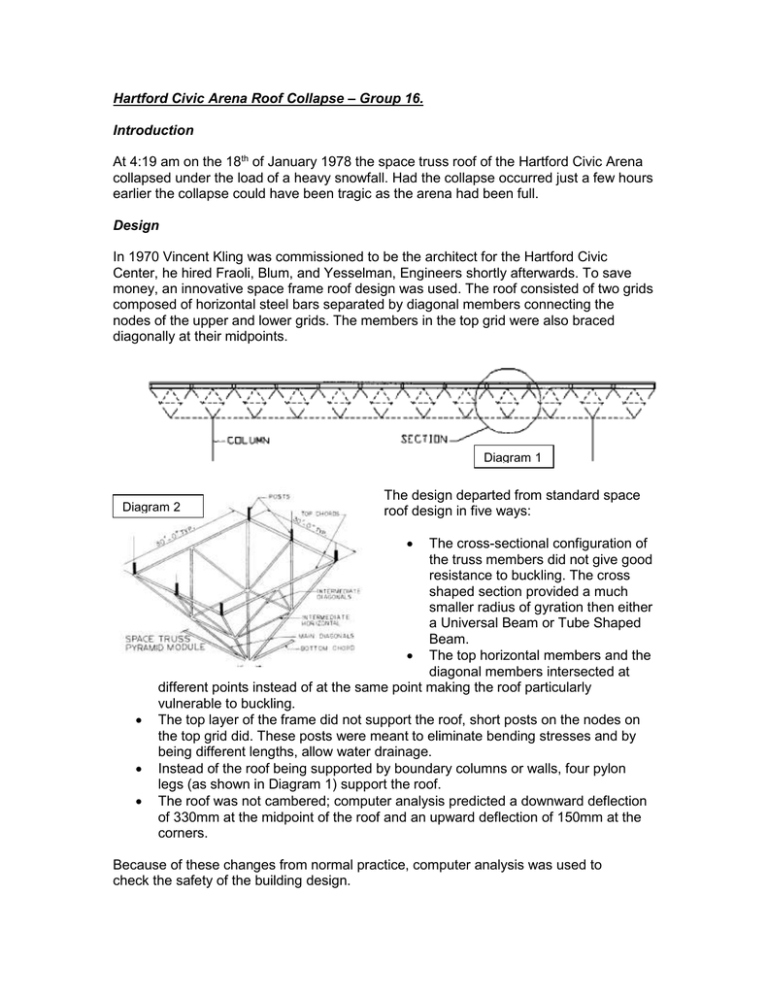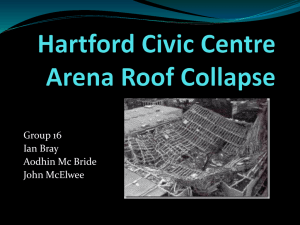Hartford Civic Arena Roof Collapse - Group 16.doc
advertisement

Hartford Civic Arena Roof Collapse – Group 16. Introduction At 4:19 am on the 18th of January 1978 the space truss roof of the Hartford Civic Arena collapsed under the load of a heavy snowfall. Had the collapse occurred just a few hours earlier the collapse could have been tragic as the arena had been full. Design In 1970 Vincent Kling was commissioned to be the architect for the Hartford Civic Center, he hired Fraoli, Blum, and Yesselman, Engineers shortly afterwards. To save money, an innovative space frame roof design was used. The roof consisted of two grids composed of horizontal steel bars separated by diagonal members connecting the nodes of the upper and lower grids. The members in the top grid were also braced diagonally at their midpoints. Diagram 1 Diagram 2 The design departed from standard space roof design in five ways: The cross-sectional configuration of the truss members did not give good resistance to buckling. The cross shaped section provided a much smaller radius of gyration then either a Universal Beam or Tube Shaped Beam. The top horizontal members and the diagonal members intersected at different points instead of at the same point making the roof particularly vulnerable to buckling. The top layer of the frame did not support the roof, short posts on the nodes on the top grid did. These posts were meant to eliminate bending stresses and by being different lengths, allow water drainage. Instead of the roof being supported by boundary columns or walls, four pylon legs (as shown in Diagram 1) support the roof. The roof was not cambered; computer analysis predicted a downward deflection of 330mm at the midpoint of the roof and an upward deflection of 150mm at the corners. Because of these changes from normal practice, computer analysis was used to check the safety of the building design. Problems In order to save money, the roof was built on the ground. While it was still on the ground the engineers were notified that excessive deflections had been found at some of the nodes. Once the roof was put into position the deflections were measured and found to be twice that which was predicted by the computer analysis. Again, the engineers were notified but they claimed that such derivations from the theoretical deflections were to be expected. When a subcontractor was attempting to fit the steel frame supports for fascia panels on the outside of the truss difficulties were encountered due to excessive deflections. Approximately a year after the building was constructed, a citizen contacted the engineers to express concern about the large deflection he’d noticed. They were assured that the building was safe. Collapse After the building had collapsed it was determined that three major design errors, as well as an underestimation of the design dead load of 20% allowed the load of the snow to collapse the roof. The top layer’s exterior compression members on the east and west faces were overloaded by 852% The top layer’s exterior compression members on the north and south faces were overloaded by 213% The top layer’s interior compression members in the east-west direction were overloaded by 72% The diagram to the left illustrates some of differences between the original design and the design as was implemented on site. As can be seen, the difference caused a huge reduction in the allowable forces for the structure. The diagonal members were attached some distance below the horizontal members. The flexibility of the connection reduced the effectiveness of the bracing by introducing a spring brace instead of the hard brace that had been assumed. The most overstressed members in the top layer buckled under the snow load, leading to the bucking of other members and the collapse. What can be learned from the disaster? After studying why and how the Hartford Civic Centre Roof disaster occurred, it is important to examine the implications and lessons that can be learned from such a catastrophic and life-threating disaster. Engineers often concentrate on engineering marvels and successes, and while this is understandable and worthwhile, it is also extremely important that we study and learn from engineering disasters. Important and valuable lessons and issues can always be obtained from incidents where the unexpected or undesired occur. Theses issues may be technical, procedural or ethical concerns. The issues mentioned above will be discussed in relation to the Hartford Civic Centre Roof Disaster. Computer vs. Reality The Hartford Civic Centre Roof was a new and innovative design, and so required a complex computer software package to model its behaviour under loading. This was one of the pitfalls which the roof designers fell into. The computer model provided a false sense of security for the designers who did not consider any other modes of failure other than those examined in the computer programme. As it occurred, a small deviation in the as-built detail of one of the joints as compared with the computer model resulted in serious reduction in loading capacity of the joint. The computer model also didn’t highlight the lack of redundancy in the structure which accelerated the overall failing and buckling of the roof’s members. It is therefore important that engineers and designers use computer analysis as a tool in the overall structural analysis of buildings and not to treat its output as complete or final. A computer analysis is only as good as its programmer and so engineers must have a deep understanding of the expected outcome and overall behaviour of such analysis. Over-reliance on computer models and outputs is a very dangerous and potentially disastrous trait for an engineer to have. Who’s in Charge? The Hartford Civic Centre contract was divided into different subcontracts. The overall construction was overseen by a construction manager, who was responsible for the project as a whole. The construction manager was not a qualified structural engineer and so was not concerned with the structural implications of the bowing roof, even when informed from several sources. Indeed at the start of the construction phase the involvement of a structural engineer for inspection purposes was deemed to be a waste of money. The splitting up of the contract resulted in a disjointed, fragmented construction period which led to a lack of responsibility on any of the subcontractor’s part. This in turn allowed errors in construction not been detected or rectified. This highlights the importance of having a structural engineer on site in charge of inspection procedures. A structural engineer or designer would understand the structure and the excessive deflections as reported in this case. This dangerous behaviour of a building would concern the structural engineer and they would order a recheck or recalculation of the design for fear of potential problems in the future. Listening to Others Several times during the construction phase the engineer and construction manager were informed of the unusual excessive deflections in the arena’s roof (i.e. layperson, inspection agency and subcontractor.) Each time the engineer and manager reassured the concerned that the deflections were normal and safe. Indeed subcontractors placing fascia boards were told to “deal with the problem”. The engineer was so confident in his design and computer model that he ignored these important warning signs and chose instead not o investigate their cause. Investigation of unusual behaviours of a structure as was the case in the Hartford Civic Centre usually indicates serious deficiencies overseen in the design process and so can also be an insight into the future behaviour of the structure. The engineer in this case however chose to ignore the warning signs even though the as-built behaviour differed considerably from the computer model. This should have set alarm bells ringing and a recheck of calculations should have been ordered, unfortunately this did not happen and the failure of the roof followed. Engineers should pay attention to unexpected behaviours in structures and should listen to concerns of everybody involved in construction phase (even the general public), and rechecks of design should follow when concerns are raised. Conclusion If all or some of the lesson’s learned from such engineering disasters as above are understood and taken on board by all engineers, young and old, then such failures may hopefully become even more rare and the risk of injury or death to society who use the designed structures of the world may be dramatically reduced. References http://www.eng.uab.edu/cee/REU_NSF99/hartford.htm http://www.eng.uab.edu/cee/reu_nsf99/Report.PDF Levy, Matthys and Salvadori, Mario (1992), Why Buildings Fall Down: How Structures Fail. W. W. Norton, New York, NY

![Hartford_presentation[1].pptx](http://s2.studylib.net/store/data/015465403_1-8ba5aa7fb8003bb43fc5c5094028e64b-300x300.png)



